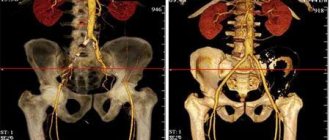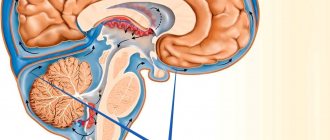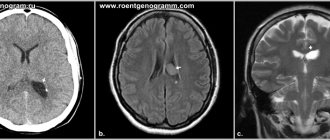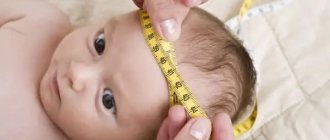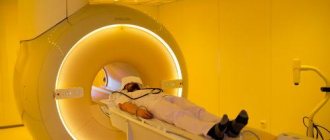- Home >
- Directory >
- At what age can a child have an MRI of the brain?
Has the doctor prescribed your child to undergo an MRI of the brain? Are you worried that the examination may harm your fragile body? We will tell you in this article whether MRI of the brain is dangerous for a child and at what age an MRI examination can be performed!
Features of the procedure
When a child is indicated for an MRI, parents may worry about this even more than the children themselves. But there is nothing to worry about - this is one of the most comfortable diagnostic procedures. Some problems may arise only with the study of very young children, who cannot be explained that they must lie still during the procedure. In this case, the study can be carried out during sleep in an open tomograph.
For older children, the examination can be carried out without any special restrictions (in any case, if the child does not suffer from claustrophobia or diseases in which involuntary movements are observed). If the child is too small or suffers from a fear of closed spaces, the examination can be performed under general anesthesia. This is not always possible - for example, MRI of the brain is usually not performed under anesthesia. Consult your doctor.
If the child is old enough and can lie still during the entire examination, the procedure is no different from examining an adult.
Brain MRI for a child
MRI itself does not harm a person, even the smallest one, but a child may experience some anxiety due to the following factors:
- Loud noise from the tomograph
- The need to remain still
- Closed space (in cases of MRI on closed tomographs)
For children under 5-7 years of age, MRI is performed under anesthesia to avoid unnecessary fear and movement. MRI can also be performed on infants, but in this case complementary feeding must be done 2 hours before the examination.
When can an MRI be prescribed for children?
Magnetic resonance imaging in childhood can be used to diagnose pathologies and abnormalities of almost any internal organ. MRI is prescribed for children if they have the following complaints or symptoms:
- Headaches or dizziness;
- Sudden causeless weight loss;
- Regular pain in the abdominal area;
- Epileptic seizures;
- Head injuries, suspected concussion;
- Fainting or loss of consciousness;
- Suspicion of the presence of neoplasms;
- Presence of birth injuries.
- Retarded physical or psychological development, severe speech delay.
Often, magnetic resonance imaging is also prescribed for children to confirm the diagnosis after other types of diagnostics (CT, X-ray, ultrasound, etc.), before surgery, or to track dynamics after treatment.
If the doctor recommends an MRI, do not delay the diagnosis under any circumstances. Timely diagnosis and treatment can avoid serious consequences.
About the areas of application of MRI studies in pediatrics:
- In cardiology Congenital heart defects, aorta, pulmonary arteries, vascular malformations (arteriovenous malformation);
- In neurology and neurosurgery Birth injuries of the head and nerve plexuses (birth paralysis), cortical dysplasia, congenital sensory hearing loss, benign and malignant tumors of the brain and spinal cord, congenital and acquired hydrocephalus;
- In oncology and hematology Neuroblastoma, lymphoma, leukemia, metabolic bone damage in various diseases, sickle cell anemia;
- In traumatology and orthopedics, pathology and diseases of the joints, household and sports injuries, osteochondropathy.
Possible contraindications
Any research technique has contraindications. Magnetic resonance imaging is not performed on children in the following cases:
- If there are metal non-removable structures in the child’s body. For example, knitting needles, plates, pins, or a pacemaker.
- Magnetic resonance imaging in closed tomographs is not performed on children with claustrophobia (fear of closed spaces).
- If it is necessary to use a contrast agent, you must make sure that there are no problems with the liver or kidneys, anemia, as well as an allergic reaction or intolerance to the components included in the contrast agents.
MRI in children is performed only as prescribed by a doctor.
MRI with contrast
In some cases, the use of contrast is required. In this case, immediately before the start of the study, the child is given an intravenous contrast agent. It is safe for the body and does not harm health. Using contrast, you can detect many pathologies at the initial stage of development, as well as determine the etiology of tumors: distinguish malignant tumors from benign ones.
Most often, MRI with contrast is prescribed for diagnosing the brain, blood vessels, or cancer screening. Before administering contrast, it is necessary to consult a doctor to exclude contraindications.
Magnetic resonance imaging for autism
In the group of patients diagnosed with atypical autism, which included 25 children, which accounted for 41% of the total number of patients with ASD, MRI signs of structural abnormalities were found, which were regarded as: 1. consequences of a previous neuroinfection (including asymmetry of the lateral ventricles) – in 9 (36%) cases 2. inflammatory changes in the paranasal sinuses and in the structures of the temporal bones – in 5 (20%) cases 3. changes corresponding to a combination of signs of the consequences of a previous neuroinfection and signs of inflammation in the paranasal sinuses and in the structures of the temporal bones bones, were determined in 4 (16%) cases 4. changes corresponding to a set of signs of the consequences of a neuroinfection with midline cysts in 2 (8%) cases. In this case, a normal MRI picture was determined in 5 (20%) cases.
Rett syndrome was diagnosed in 1 child (MRI was normal).
The group diagnosed with childhood disintegrative disorder was also small - 2 cases, which accounted for 3% of the total number of patients with ASD: in 1 case, signs of the consequences of a neuroinfection were revealed (including asymmetry of the lateral ventricles), in 1 case - changes corresponding a set of signs of the consequences of a previous neuroinfection and signs of inflammation in the paranasal sinuses and structures of the temporal bones.
In the group of patients diagnosed with Asperger's syndrome, which included 5 patients (which is 8% of the total number of patients with ASD), the following MRI signs of structural abnormalities were found: 1. consequences of a previous neuroinfection (including asymmetry of the lateral ventricles) - in 2 (40%) cases 2. changes corresponding to a combination of signs of the consequences of a previous neuroinfection and signs of inflammation in the paranasal sinuses and in the structures of the temporal bones were determined in 1 (20%) case 3. midline cysts in 1 (20%) case. In this case, a normal MRI picture was determined in 1 (20%) case.
Of the study group of 61 people, 21 (34.4%) patients showed signs of the consequences of a neuroinfection; 24 (39.3%) had signs of inflammation in the paranasal sinuses and structures of the temporal bones; in 8 (13.1%) the presence of midline cysts was determined; in 12 (19.7%) there was an MRI picture without signs of pathology in the brain and paranasal sinuses, as well as the structures of the temporal bones.
Thus, in 45 patients (which amounted to 73.7% of the total) with an established diagnosis of childhood autism and atypical autism, MRI signs of the consequences of a previous neuroinfection and MRI signs of inflammatory changes in the paranasal sinuses and/or cells of the mastoid processes of the temporal bone were revealed (see .diagram 2.).
How to prepare for an MRI?
MRI does not require complex preparation, but parents should keep in mind a few simple rules:
- Please check with your specialist in advance exactly how magnetic resonance imaging will be performed. If anesthesia or contrast enhancement is required, you must abstain from food for 5-6 hours (for infants - at least 2-3 hours)
- If the child is over 5 years old, convince him to listen carefully to the doctor and comply with all his requirements.
- If the child is small, it is advisable to schedule an MRI during his sleep (if possible). This will make it easier to achieve a stationary state.
- Remember that during the procedure there should be nothing metal on the child’s body. Therefore, remove all jewelry (earrings, cross, chain, etc.) early, and also prepare a change of home clothes without metal fittings.
- Parents may be asked to stay with the child during the examination. In this case, adults also need to make sure that there is no metal in their pockets, body or clothing.
- If you were examined using other diagnostic techniques before the MRI, if possible, take the results of previous studies with you.
How is an MRI performed?
If the child is over 5 years old, you need to tell him how the study is going and explain that during the procedure a loud noise will be heard and that there is no need to be scared. You can also use earplugs if your child is frightened by loud noises. It is important to talk about the need to lie still. If an MRI is performed in a closed-type tomograph, the child will have the opportunity to stop the study at any time by pressing the panic button.
- The examination process itself is practically no different from performing an MRI on adults. The child must wear clothes without metal inserts.
- The child will need to lie on his back on a special automatic table.
- If an MRI with contrast is planned, the drug is injected into a vein before the examination.
- The duration of the examination is about 20-30 minutes.
After receiving the images, the doctor begins to decipher them. This process can take up to one and a half hours. The doctor will prepare a report and give it to you along with the images.
Benefits of the study
Why is MRI so often chosen to examine children?
- Magnetic fields are completely harmless to the body. Therefore, the number of MRI sessions is not limited.
- Since the procedure is non-invasive, the child does not feel any pain or discomfort during the procedure.
- Using MRI, you can obtain informative images of organs in several projections, with the help of which you can diagnose pathologies or abnormalities even at the initial stage of development.
- MRI does not require lengthy, complex preparation.
- After an MRI, you can get a doctor’s report within 1-1.5 hours.
- Magnetic resonance imaging has no age restrictions; diagnostics can be performed even on infants.
MRI is a safe and informative method for early diagnosis of various pathologies for children. Remember that any pathology is much easier to treat at an early stage of development. If the first warning signs appear, consult a doctor.
Conclusions:
From the above it follows:
1. Apparently, against the background of genetic predisposition (taking into account the presence of key phases and stages of the formation of interneuronal connections in the central nervous system), it is the infectious-allergic factor that is the fundamental trigger in the mechanism of occurrence of ASD.
2. MRI examination of the central nervous system should be used as early as possible in all children with central nervous system and, in particular, ASD, not only as the most informative, but also as the most harmless for the purpose of early detection of an infectious-allergic focus that can adversely affect the normal development of the central nervous system and, hence the occurrence of ASD
3. An almost equal ratio of structural changes in the brain and facial skull in childhood and atypical autism may indicate a common etiology and exogenous trigger for these types of ASD.
4. To date, the task remains unsolved, if not eliminating, then at least reducing the toxic effects of anesthesia or sedation on the central nervous system in children with ASD during MRI studies (which is extremely necessary to eliminate motor artifacts that interfere with obtaining a high-quality image).



